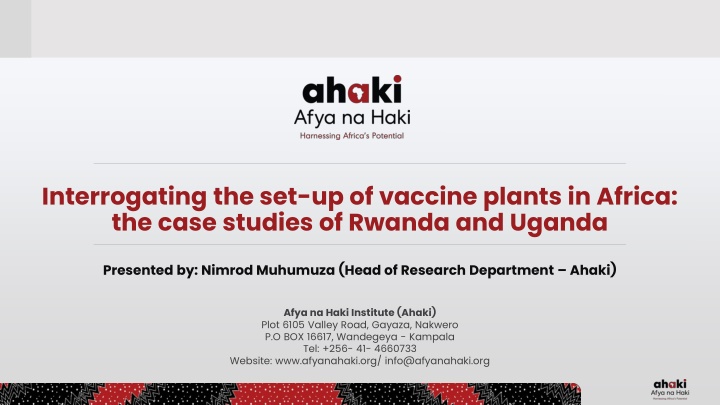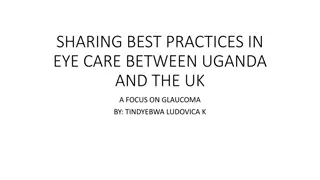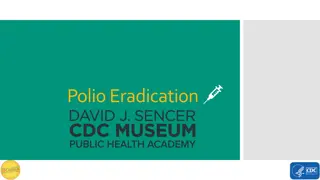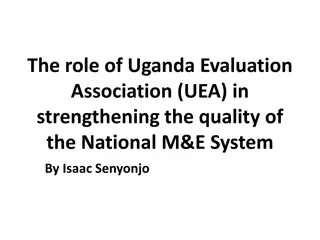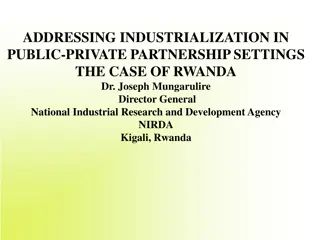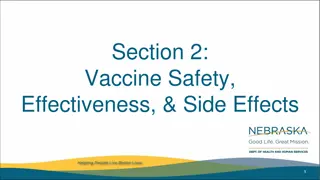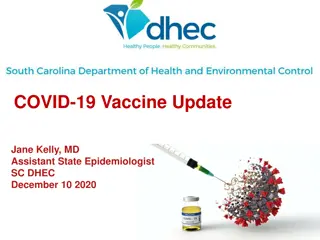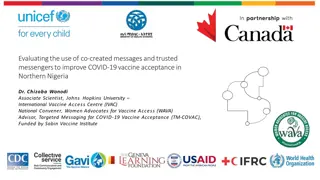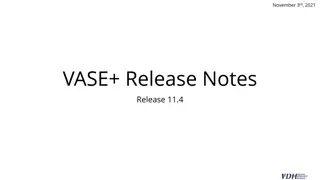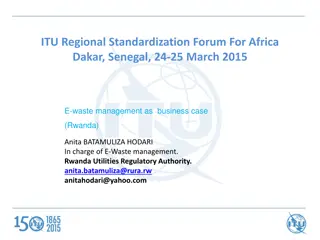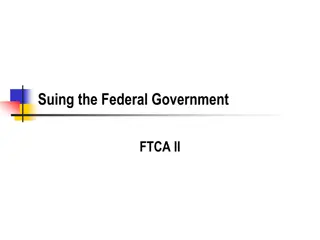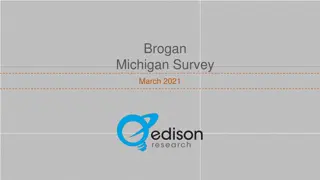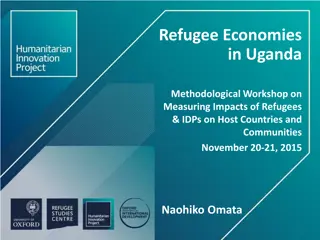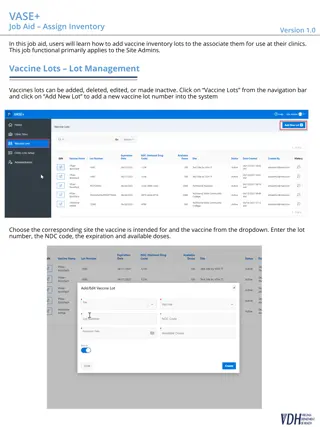Interrogating the Establishment of Vaccine Plants in Africa: Case Studies of Rwanda and Uganda
Nimrod Muhumuza, from Afya na Haki Institute, presents a critical analysis of vaccine plant setup in Rwanda and Uganda. The discussion focuses on the potential leadership roles of small economies, private sector involvement, sustainability of vaccine production, and the importance of participation for success. The context reveals low vaccine production in Africa despite high disease burden, with a call for innovation and increased investment in the sector.
Download Presentation

Please find below an Image/Link to download the presentation.
The content on the website is provided AS IS for your information and personal use only. It may not be sold, licensed, or shared on other websites without obtaining consent from the author.If you encounter any issues during the download, it is possible that the publisher has removed the file from their server.
You are allowed to download the files provided on this website for personal or commercial use, subject to the condition that they are used lawfully. All files are the property of their respective owners.
The content on the website is provided AS IS for your information and personal use only. It may not be sold, licensed, or shared on other websites without obtaining consent from the author.
E N D
Presentation Transcript
Interrogating the set-up of vaccine plants in Africa: the case studies of Rwanda and Uganda Presented by: Nimrod Muhumuza (Head of Research Department Ahaki) Afya na Haki Institute (Ahaki) Plot 6105 Valley Road, Gayaza, Nakwero P.O BOX 16617, Wandegeya - Kampala Tel: +256- 41- 4660733 Website: www.afyanahaki.org/ info@afyanahaki.org
Background Key Questions: Can two small countries/economies lead the way on the continent? What is the role of the private sector and how can we manage its excesses? What lessons can we take from successes and failures? How can we make sure these are sustainable? What the role of participation in making these a success? How can we replicate these across the continent? High disease burden necessitates innovation. 16% of the world s population and 23% of disease burden (WHO) 1% of the total global health expenditures in 2015 (Brookings Institute) Africa is expected to witness a three-fold increase in vaccine demand by 2040. 54 countries with about 1.2 billion people, and produces only 1% of the vaccines it administers. Vaccine production on the continent remains low and is largely concentrated in five countries - South Africa, Morocco, Tunisia, Egypt, and Senegal public/community
Introduction 375 drug makers, most in North Africa, to serve a population of around 1.3 billion people. Those in sub-Saharan Africa are largely clustered in just nine of 46 countries, and they re mostly small, with operations that do not meet international standards. Almost all of them are drug-product manufacturers that is, they purchase active pharmaceutical ingredients (APIs) from other manufacturers and formulate them into finished pills, syrups, creams, capsules, and other finished drugs. Up to a hundred manufacturers in sub-Saharan Africa are limited to packaging: purchasing pills and other finished drugs in bulk and repackaging them into consumer-facing packs. Only three two in South Africa, and one in Ghana are producing APIs, and none have significant R&D activity. -McKinsey (By comparison, China and India, each with roughly 1.4 billion in population each, have as many as 5,000 and 10,500 drug manufacturers, respectively.) - McKinsey And the sub-Saharan market s value is still relatively small, at roughly $14 billion compared with roughly $120 billion overall in China and $19 billion in India In sub-Saharan Africa, only Kenya, Nigeria, and South Africa have a relatively sizable industry, with dozens of companies that produce for their local markets and, in some cases, for export to neighboring countries - McKinsey
Rwanda In-situ context: Small, landlocked. 12 million people. Low-income country. GDP of $13 billion. Pharma market remains underdeveloped at USD165M. Disease burden: Both acute and chronic infectious diseases (Malaria, HIV, and lower respiratory infections) have been the top causes of mortality in Rwanda. More recently, NCDs have risen among the population. In 2017, 33% of deaths in Rwanda were attributable to NCDs, according to the (WHO): Rwanda is also addressing its burden of lower respiratory infections, tuberculosis, diarrheal infections, and malaria. Vaccination: Following the Rwandan genocide in 1994, vaccination rates were nearly non-existent. Extreme poverty, rural populations, and mountainous geography all impeded vaccine accessibility. After the genocide, other factors that hindered immunization efforts included a lack of immunization program infrastructure and lack of widespread awareness and demand among the population Rwanda has achieved near-universal childhood vaccination rates, with an overall national coverage rate for childhood immunization of 98% in 2015. Rwanda had fully vaccinated over 60% of its population by 2022.
What explains Rwandas successes? ADB: Establishment of the African Pharmaceutical Technology Foundation. To better scout and negotiate with global pharma to facilitate local production EU & Rwanda partnership between Rwanda and several EU state regulatory agencies AMA Secretariat Establishment of an African Pharmaceutical Academy Regulatory systems: Law No 003/2108 establishing the FDA. The Africa Medicines Agency (AMA), established by the African Union in 2019, is headquartered in Rwanda and is well- positioned to provide the necessary regulatory oversight. The AMA will facilitate intracontinental vaccine trade. AMA will establish regulations that will serve as minimum standards to promote: The development of Africa's knowledge base by encouraging advanced biotech research; Knowledge exchange between academia and the private sector; The establishment, retention, and attraction of private biotech firms in the African market; and Domestic competitiveness through tax incentives and subsidies for venture capital and institutional investments in the local biotech and vaccine manufacturing industry.
Rwanda Culture of accountability. The entire health system in Rwanda is characterized by a culture of accountability. This culture is exemplified by the implementation of performance contracts known as imihigo, meaning a vow to deliver which bind all government personnel at various levels of authority. Accountability is established between the central ministries and the President, the district mayors and the central ministries, and the health centers and district mayors. This ensures that the health system is well-represented at all levels of government, guaranteeing the effective delivery of vaccinations and other healthcare services.
Rwanda Local ownership: . Rwanda's successful immunization program owes much to the local-level ownership it possesses. Community Health Workers (CHWs) play a crucial role as elected representatives of the local health system. Their responsibilities include educating the community about childhood vaccinations and ensuring all children receive them. While vaccinations are administered at district health centers, CHWs mobilize communities and work closely with health centers to identify unvaccinated children. They attend monthly meetings, receive lists of unvaccinated children, and leverage their knowledge of the community to assist in getting children vaccinated. CHWs are also trained to detect and report cases of vaccine-preventable diseases promptly. By collecting vaccination data through RapidSMS, a cell phone-based program, CHWs contribute to strengthening community health and ensuring comprehensive vaccine coverage.
Rwanda Robust logistics and data collection systems:. A national health information system ensures effective tracking of every child, enabling the timely administration of vaccinations. Through a comprehensive monitoring system, children in need of vaccination can be identified, and a well-functioning supply chain guarantees the reliable distribution of vaccines. CHWs play a vital role in this bottom-up approach, providing data through the RapidSMS and mUbuzima systems. District monitoring officers receive training in data analysis, facilitating local adaptation, while aggregated data is analyzed centrally. The Ministry of Health combines data sources in the National Data Warehouse, swiftly identifying lower vaccination rates and guiding necessary interventions.
Rwanda: BioNTech Establishment of BioNTech in Rwanda Result of agreement between Rwanda and BioNTech to manufacture COVID-19 vaccines and later malaria and TB (50-100 million doses a year) First time an API for COVID-19 will be manufactured in Africa $116M investment Facility comprises of containerized labs manufactured in Germany and installed in Rwanda Initially, facility to be managed and operated by BioNTech staff. Ownership and expertise to transfer to local operations after a decade
Uganda Context: An upward growth trend, and over the last fifteen years, has evolved from two large manufacturing plants registered in the mid-1990s to fifteen companies of varying sizes in 2022. In early 2010, the country s largest pharma manufacturer, CIPLA, received the WHO Good Manufacturing Practices (GMP) certification for the production of ARVs and artemisinin-based combination therapies (ACTs) for the treatment of HIV/AIDS and malaria, respectively. These firms also manufacture medicines and health supplies including basic essential formulations, tablets and capsules, syrups for children, and creams. (EQUINET) Pharmaceutical manufacturing context: 11 licensed local pharmaceutical manufacturers & 55 local pharmaceutical distributors; 500 registered pharmacies and 4,000 chemist shops. Estimated annual value of local pharma sector - $450M; Export value in 2017 - $15M Disease burden: Uganda s burden of disease is dominated by communicable diseases, which account for over 50% of morbidity and mortality. Malaria, HIV/AIDS, TB, and respiratory, diarrhoeal, epidemic-prone, and vaccine-preventable diseases are the leading causes of illness and death. There is also a growing burden of non-communicable diseases (NCDs) including mental health disorders. Maternal and perinatal conditions also contribute to the high mortality as well as Neglected Tropical Diseases (NTDs). Furthermore, there are wide disparities in health status across the country, closely linked to underlying socio-economic, gender, and geographical disparities. WHO Vaccination: Can be improved. For instance the vaccination completion rate among children aged 12-23 months in Uganda remains suboptimal despite the availability of vaccines. Overall vaccination completion was 48.6% and ranged from 17.3% in Central to 65.9% in Southwest. (1995- 2016) Okello et al 46% of people in Uganda have received at least one vaccine dose, and 33% are fully vaccinated as of December 2022 - IHME
Uganda case study of a Ugandan start-up Policy and regulatory framework: Exists through a number of laws, policies and institutions e.g. National Drug Authority Act; NEMA, Investment Code Act, Local Government Act etc. In our study, specialized agencies i.e NEMA, NDA were fast and efficient in providing regulatory approvals for the construction of a pharmaceutical manufacturing plant. Lack of clarity prevails particularly regarding the tax incentive regime. Respondent waited 9 months to obtain approval from URA before shipping goods. The most expensive imports, factory fittings, for establishing a pharma plant were ineligible for tax exemption. Incentives only accessible through referral. No standardized method of access. Need for a framework that guarantees equal opportunities Production and market: Valued at $450 million, (only 20% for the local market) the pharmaceutical sector makes up approximately 0.16% of Uganda s GDP at current market prices, according to the Uganda Pharmaceutical Manufacturers Association (UPMA). Asoko Insight; the pharmaceutical sector generated exports worth $15.02 million in 2017. Respondent not feasible to obtain a number of crucial inputs locally and have to import. Absence of appropriate varieties of maize throughout the year Human resource: SF Similar to Rwanda's experience with BioNTech. Investors are relying on engineers from India, Kenya. Respondent hired a team of 38 Indian nations to undertake wiring and other fittings. "Country has no people with hands-on skills to run pharma plants" Financing: Investor spent $3M. 60% from a Bank at 24% p.a
Key Lessons for us: Harmonization of regulation quality assurance Market integration. Fragmented markets are not ideal for economies of scale Financing: Biggest elephant in the room. Determines sustainability, sufficiency, quality, autonomy and independence Leveraging public-private partnerships What model do we want to recreate? Neo-liberal? What is the role of the state beyond regulation
THANK YOU Afya na Haki Institute (Ahaki) Plot 6105 Valley Road, Gayaza, Nakwero P.O BOX 16617, Wandegeya - Kampala Tel: +256- 41- 4660733 Website: www.afyanahaki.org/ info@afyanahaki.org
